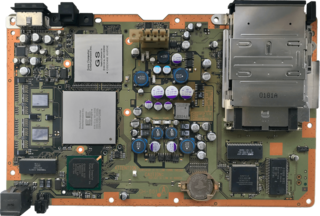Related Research Articles

Alpha is a 64-bit reduced instruction set computer (RISC) instruction set architecture (ISA) developed by Digital Equipment Corporation (DEC). Alpha was designed to replace 32-bit VAX complex instruction set computers (CISC) and to be a highly competitive RISC processor for Unix workstations and similar markets.

Industry Standard Architecture (ISA) is the 16-bit internal bus of IBM PC/AT and similar computers based on the Intel 80286 and its immediate successors during the 1980s. The bus was (largely) backward compatible with the 8-bit bus of the 8088-based IBM PC, including the IBM PC/XT as well as IBM PC compatibles.

PowerPC is a reduced instruction set computer (RISC) instruction set architecture (ISA) created by the 1991 Apple–IBM–Motorola alliance, known as AIM. PowerPC, as an evolving instruction set, has been named Power ISA since 2006, while the old name lives on as a trademark for some implementations of Power Architecture–based processors.
The NS32000, sometimes known as the 32k, is a series of microprocessors produced by National Semiconductor. The first member of the family came to market in 1982, briefly known as the 16032 before becoming the 32016. It was the first 32-bit general-purpose microprocessor on the market: the Motorola 68000 could process 32-bit data and stored addresses in 32 bits but could only address 16MiB of RAM and had a 16-bit ALU, whereas the 32000 series was described in 1983 as the only microprocessor available at that time with 32-bit internal data paths and ALU. However, the 32016 contained a large number of bugs and often could not be run at its rated speed. These problems, and the presence of the similar Motorola 68000 which had been available since 1980, led to little use in the market.

The Risc PC is Acorn Computers's RISC OS/Acorn RISC Machine computer, launched on 15 April 1994, which superseded the Acorn Archimedes. The Acorn PC card and software allows PC compatible software to be run.

Geode was a series of x86-compatible system-on-a-chip microprocessors and I/O companions produced by AMD, targeted at the embedded computing market.

QEMU is a free and open-source emulator. It emulates the machine's processor through dynamic binary translation and provides a set of different hardware and device models for the machine, enabling it to run a variety of guest operating systems. It can interoperate with Kernel-based Virtual Machine (KVM) to run virtual machines at near-native speed. QEMU can also do emulation for user-level processes, allowing applications compiled for one architecture to run on another.
DeskStation Technology was a manufacturer of RISC-based computer workstations intended to run Windows NT. DeskStation was based in Lenexa, Kansas.
Loongson is the name of a family of general-purpose, MIPS architecture-compatible microprocessors, as well as the name of the Chinese fabless company that develops them. The processors are alternately called Godson processors, which are described as its academic name.

Tadpole Computer was a manufacturer of rugged, military specification, UNIX workstations, thin client laptops and lightweight servers.

The SPARCstation 20 or SS20 is a discontinued Sun Microsystems workstation introduced in March 1994 based on the SuperSPARC or hyperSPARC CPU. It is one of the last models in the SPARCstation family of Sun "pizza box" computers, which was superseded by the UltraSPARC design in 1995.
Jiangsu Lemote Tech Co., Ltd or Lemote is a computer company established as a joint venture between the Jiangsu Menglan Group and the Chinese Institute of Computing Technology, involved in computer hardware and software products, services, and projects.
The Classmate PC, formerly known as Eduwise, is Intel's entry into the market for low-cost personal computers for children in the developing world. It is in some respects similar to the One Laptop Per Child (OLPC) trade association's Children's Machine (XO), which has a similar target market. Although made for profit, the Classmate PC is considered an Information and Communication Technologies for Development project (ICT4D). Introduced in 2006, the device falls into the then popular category of netbooks.

Zonbu was a technology company that markets a computing platform which combines a web-centric service, a small form factor PC, and an open source based software architecture. Zonbu was founded by Alain Rossmann and Gregoire Gentil.
The Elonex ONEt is a netbook computer marketed to the education sector in the UK by Elonex. Inspired by the OLPC initiative, the low cost of the ONE, the ONEt and similar devices, made this subnotebook seem an attractive proposition for educators seeking to provide every child with a highly functional laptop computer. However initial ONEt trials by educators claimed that the lack of security, specifically the absence of any password protection at start-up, put personal information at risk, making it unsuitable for use in a school environment. It was released in September 2008, on sale to the general public, marketed as an upgrade to the ONE. It has Wi-Fi connectivity, a solid-state hard drive, three USB ports and an SD card slot.

The Skytone Alpha-400 is a Linux-based low-cost netbook with a 7 in 800×480 LCD screen, introduced in 2008. Its measurements (length×width×depth) are 210×140×32 mm and it weighs 0.65 kg.

The PlayStation 2 technical specifications describe the various components of the PlayStation 2 (PS2) video game console.
Since 1985, many processors implementing some version of the MIPS architecture have been designed and used widely.

The IBM ThinkPad Power Series(800/820/821/822/823/850/851/860) is a laptop series from the ThinkPad line that was manufactured by IBM. It is based on the PowerPC architecture.
